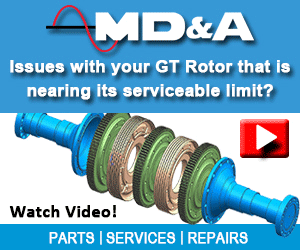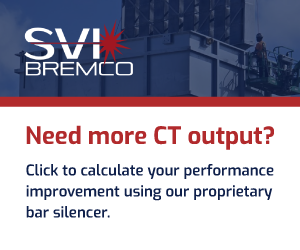The Rotor Life Roundtable, chaired by Tracy Dreymala of EthosEnergy Group, covered issues, procedures, and capabilities of life-extension programs. The following seven vendors participated with brief overviews of their companies’ capabilities/activities, before Chairman Dreymala opened the discussion portion of the session:
-
- Scott Kennedy, Veracity Technology Solutions.
- Doug Sewell, Sulzer Turbo Services Houston Inc.
- Paul Tucker, FIRST/TBS.
- Hilary Magner, NRG Energy Services.
- Richard Rucigay, MD&A.
- Pete Miranda, Nord-Lock Inc/Superbolt Inc.
- Kale Dreymala, EthosEnergy Group.
With more than 400 7EAs expected to reach the end-of-life parameters established in GER-3620N (October 2017), “Heavy-Duty Gas Turbine O&M Considerations,” within 10 years, this roundtable attracted a great deal of interest.
Snippets of information gleaned from both the company-capability overviews made by each of the panelists and the open-discussion segment of the program are summarized in the bullet points below.
The opening remarks of Paul Tucker, FIRST/TBS, was indicative of the panelists’ experience and the depth of knowledge accessible to the user attendees. Tucker said his company has been conducting end-of-life (EOL) inspections on gas-turbine rotors since 2007. The list includes: 10 Frame 3s, 31 Frame 5s, eight Frame 6s, 20 Frame 7s, six W251s, and four W501s. Roughly half of the rotors inspected were hours-based, half starts-based.
Regarding the value of EOL inspections to engine owners, Tucker said FIRST/TBS’s program had, by the time of the 2017 meeting, enabled the rotors examined to operate 4.7-million more hours and start nearly 200,000 more times.
Concerning inspection results, Tucker reported that flaws were found in 17 of the 563 wheels/discs checked; 13 wheels were replaced in the 11 rotors requiring follow-on work. One-third of the 13 were compressor wheels.
NRG reported having performed five rotor life assessments since 2013, with the lives of those rotors each extended by 100,000 hours.
Veracity explained that current inspection techniques—especially phased-array ultrasonic, which provides 3D measurements of internal discontinuities—were not available when most engines in the 7B-EA fleet were ordered and almost all wheel forgings have discontinuities that have been present since manufacture. The new capabilities for mapping internal flaws can provide engineers data to help calculate remaining life going forward.
There is no “industry standard” available to vendors that perform rotor life-extension programs. Each establishes its own process, guidelines, and disposition documentation—typically based on an in-house engineering evaluation and experience.
A user asked, “How long can a rotor’s life be extended?” The vendors answered in many different ways, perhaps best summarized as “It depends.”
Tucker shared his opinion that if wheel inspections reveal proper metallurgy and internal flaws are “cleared,” a rotor likely is good to run indefinitely, provided surface creep is monitored. You are not going to find a “birth defect” flaw after a detailed inspection, he said. Other vendors suggested 100,000 hours as the life-extension norm, but again there is no industry standard to validate this claim. A user commented that a rotor with a 200,000-hr extension had been shipped from the OEM’s Greenville shop after its EOL inspection.
Vendors typically unstack the compressor, remove the last four stages of blades (usually damaged in the process), and perform detailed wheel inspections during their EOL evaluations. Most panelists recommended a complete compressor wheel inspection to get a 150,000-hr life extension.
A user asked the roundtable panelists to address a comment attributed to the OEM earlier in the day that the GE standard (in its rotor life-extension program) was a mandatory replacement of the aft compressor stub shaft. One panelist commented that he had seen a rotor recently returned from a GE inspection that did not have the aft stub shaft replaced. All on the roundtable panel did not believe a mandatory replacement was required.
A user asked which turbine wheels have defects. The roundtable vendors said they have found defects in all stages from time to time.





